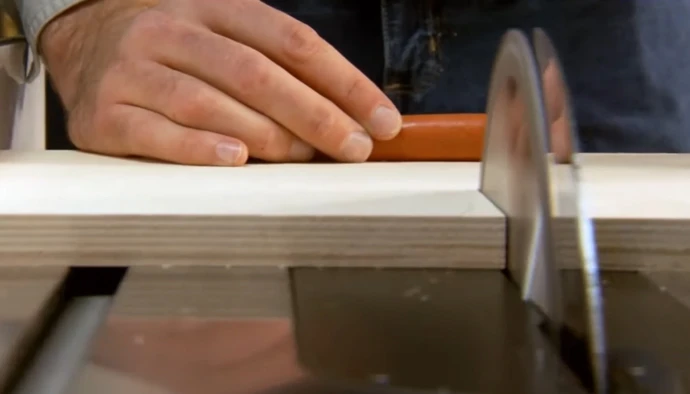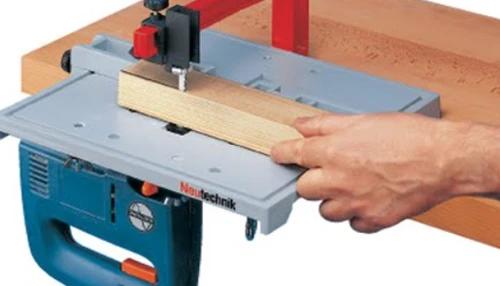Last Updated on July 17, 2022
If your table saw is slowing down, you may be wondering what’s causing it. If you’re using it for woodworking, there are several common reasons that it can bog down.
These include problems with the transmission, motor, extension cord, and miter gauge. To solve your saw’s problem, read on to learn how to diagnose its causes. If you’re still not sure, try these solutions.
Problems with the motor
One of the most common problems with table saws is a blown motor or switch. While the motor and switch are easy to replace, there are some common causes for these problems, such as a dust buildup in the motor switch or a blown run or start capacitor.
If you see smoke or an excessive amount of heat while cutting, the switch is likely malfunctioning. If the saw is not starting, check for other issues like damaged wires, and reset the circuit breaker.
Next, check the power cord. Is the cord loose? If it is, tighten it. If it is, check the thermal overload switch, which is usually located on the motor. If the red reset switch doesn’t bring the motor back to life, the breaker has probably tripped.
Otherwise, the saw may be overworking itself. This could be due to a dull blade or by pushing wood too quickly.
Another common issue with table saw motors is a slow start. The motor may be overheating or have a loose nut. Checking the motor temperature can also help determine whether a problem is with the motor.
If the motor is overheating, it indicates an internal defect in the machine. In addition, clogged sawdust may also cause the table saw to start slowly. In any case, it’s essential to replace worn motor brushes to solve these issues.
Another common problem is sawdust in the motor switch. You can replace this by unscrewing the motor housing casing. If this doesn’t solve the problem, the most likely cause is a capacitor blowout or burnt start windings.
Eventually, the motor will fail to start. A new motor will probably be needed, but it’s not very expensive. So, if you don’t want to take the motor apart, it’s better to take it to a professional for overhaul.
Problems with the transmission
If the table saw is bogging down, the drive belt may be the culprit. To identify if the belt is the culprit, check the manual carefully. If it’s a standard belt, it may be worn. If so, replace it.
The better quality drive belts have segments that can be replaced and last longer. If the drive belt is segmented, however, it may be a better idea to replace it.
Alternatively, you may be experiencing a broader problem. Your table saw may have lost power. Regardless of what the cause of this problem is, it is a very frustrating experience.
Fortunately, the causes of table saw bogging down are often very easy to fix. Regular maintenance and cleaning your workspace can prevent this problem. If you are unsure, you can always seek professional help. If you’re unsure of the cause, you can try the following solutions:
Problems with the extension cord
When a table saw is bogging down, it can be one of several issues. This can be a problem with the extension cord or a loose connection, or it can be due to your inexperience with the material.
If this is the case, you can try adjusting the blade speed or increasing the torque. In many cases, the problem can be easily fixed with some basic tools.
The most common reason for a table saw to bog down is the blade. While this is a relatively easy fix, it’s always important to check the blade to make sure it’s still sharp.
Another possible cause is problems with the power source. Make sure you have an extension cord or wall-mount power adapter that matches the model of your table saw. If you can’t find the right cord or plug, contact a professional.
The extension cord may not be rated for the saw’s horsepower. If this is the case, it could take a while before the saw trips the overload switch. In some cases, if it doesn’t trip, the problem is with the extension cord. You can also check whether your blade has been moved since you last used it.
Try using a vernier caliper to measure its alignment. You can measure the tooth just above the center plate on the leading and trailing edges and the numbers should be within a few thousandths of an inch.
Problems with the miter gauge
If you’ve ever had a problem with your miter gauge while using a table saw, it’s not the end of the world. There are solutions for these problems, and the miter gauge can help you produce consistent and accurate cross cuts for years to come.
These tools are not only an important part of woodworking, but they also make your life easier and your projects better. If you’re having problems with your miter gauge, read on to discover how to fix them.
The problem with many miter gauges is that the face of the table saw is too small for large pieces of wood. Even if the miter gauge has a wide-opening slot for an adapter board, the face of the blade is never perfectly square.
This error is reproduced on each cut, and eventually accumulates into a huge problem. For this reason, you should avoid using the mitre gauge to cut a wide-angle board.
In order to fix problems with your miter gauge, you should always use a long-edged square. Using a long-edged square is an effective way to identify the misalignment of the miter gauge.
Use a square that has a long edge to measure the miter gauge and to set the proper angles. By following these tips, you’ll be able to square the miter gauge and make your cuts accurately.
Another common problem with miter gauges is that it is not long enough. While the miter gauge has a long fence, the wood tends to move unevenly.
When using it to cut a square board, you’re likely to end up with a piece that won’t be perfectly square, and this will result in an inaccurate final cut. As a result, you may not be able to see the coving unless you use a magnifying glass or an artists square.
Problems with the fence
If your table saw has slowed down and the fence is not parallel with the miter slots, there could be a problem with the fence alignment. First, check that the fence is parallel to the miter slots and is 90deg vertical to the table top.
The adjustment process depends on the fence style, so read the manual carefully. Then, square the fence with a dial indicator or combo square. Finally, lock the fence in place.
In order to correct this issue, the rip fence and miter gauge need to be aligned with the blade. To adjust them, loosen and tighten the bolts sequentially. Then, align the miter gauge slot with the fence surface.
If the fence is not parallel to the blade, the wood will be stressed. To avoid this problem, check the fence with a straightedge. If the fence is positioned off-center, the blade will not cut correctly.
Besides problems with the fence, some wood species are particularly prone to burning. These include mahogany, walnut, cherry, and maple. Increasing the feed rate will help reduce the amount of heat produced.
Using a suitable blade will also help solve the burning issue. When determining the correct blade for your wood, be sure to read the manual carefully. If it’s not, replace it.
If you can’t determine the exact problem with the fence, you can contact a repair shop or service center. If the problem persists, it might be time for a replacement table saw.
Cleaning and maintenance are necessary to avoid the problems that lead to table saw bogging down. In some cases, you might need to upgrade the model. If the fence is too high, the saw may lose power.
Frequently Asked Questions (FAQs)
– Why does my table saw bog down when I try to cut wood?
There could be a few reasons why your table saw is bogging down when you try to cut wood. One possibility is that the blade you are using is not sharp enough. If the blade is dull, it will take more effort to push the wood through the saw, which can cause the motor to bog down.
Another possibility is that you are trying to cut too thick of a piece of wood. The table saw can only handle so much thickness at once, so if you are trying too thick, it will bog down.
Finally, there could be something wrong with the motor itself. If the motor is struggling to turn the blade, it will cause the saw to bog down. If you think this might be the case, you should take it to a professional to have it checked out.
– What are some causes of a table saw bogging down?
Some possible causes of a table saw bogging down are a dull blade, trying to cut too thick of a piece of wood, or a struggling motor.
– Is there anything I can do to prevent my table saw from bogging down?
There are a few things you can do to help prevent your table saw from bogging down. First, make sure that you are using a sharp blade. A dull blade will require more effort to push the wood through, which can cause the motor to bog down.
Second, try to cut thinner pieces of wood. The table saw can only handle so much thickness at once, so thinner pieces will be easier for it to cut.
Finally, make sure the motor is in good working condition. If the motor is struggling to turn the blade, it will cause the saw to bog down. If you think there might be an issue with the motor, take it to a professional to have it checked out.
Verdict
The most likely reason your table saw is bogging down is because the blade is dull. A dull blade will cause the saw to work harder to cut through the material, which can cause the saw to bog down. Another possibility is that the fence is not set properly, which can cause the blade to bind and bog down.




